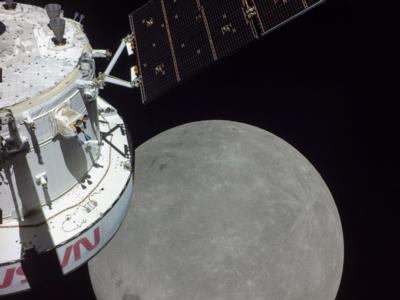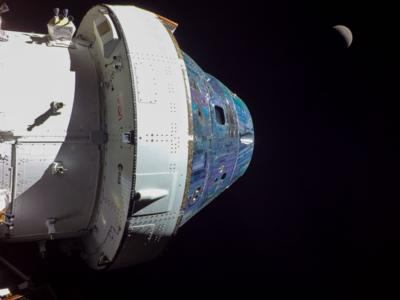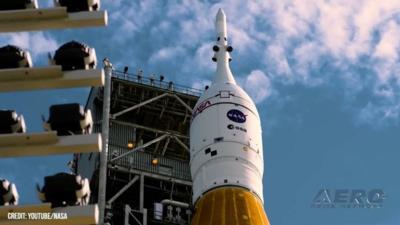Four to Go
NASA and the Canadian Space Agency (CSA) made public the names of the four astronauts selected to serve as the Artemis II mission’s primary crew.

Over the approximate ten-day duration of the Artemis II mission, the company of three NASA and one CSA spacefarers will travel to and orbit the moon before returning to Earth. The names of the crew-members were revealed on Monday, 03 April 2023 during an event at Ellington Field (EFD) near NASA’s Johnson Space Center in Houston, Texas.
NASA Administrator Bill Nelson stated: “The Artemis II crew represents thousands of people working tirelessly to bring us to the stars. This is their crew, this is our crew, this is humanity's crew. NASA astronauts Reid Wiseman, Victor Glover, and Christina Hammock Koch, and CSA astronaut Jeremy Hansen, each has their own story, but, together, they represent our creed: E pluribus unum—out of many, one. Together, we are ushering in a new era of exploration for a new generation of star sailors and dreamers—the Artemis Generation.”
NASA astronaut Reid Wiseman will serve as Artemis II’s commander. The mission will be piloted by NASA astronaut Victor Glover. NASA astronaut Christina Hammock Koch and CSA astronaut Jeremy Hansen will serve as Artemis II mission specialists one and two respectively.
Artemis II is the Artemis program’s final rehearsal flight prior to the critical Artemis III mission, which will attempt to land human beings on the lunar surface for the first time in half-a-century. After the fashions of Apollo 8 and Apollo 10—which traveled to and orbited the moon for purpose of vetting the technologies, hardware, and methods by which Apollo 11 astronauts Neil Armstrong and Buzz Aldrin would, in July 1969, land on the lunar Sea of Tranquility—Artemis II will shakedown the Orion spacecraft over a mission profile comprising a multi-burn Trans-Lunar-Injection (TLI) and a free return trajectory from the moon.
Prior to departing for the moon, the Artemis II crew will pilot the Orion spacecraft to a high Earth orbit with a period of roughly 42 hours. Once established in subject orbit, the crew will perform various checkouts of the spacecraft's life-support systems as well as an in-space rendezvous and proximity operations demonstration utilizing the Space Launch System’s spent Interim Cryogenic Propulsion Stage (ICPS) as a target. Upon once again reaching the orbit’s perigee—that point at which the spacecraft is nearest the Earth—Orion’s main engine will be fired to complete the TLI maneuver by which craft and crew will be established upon a lunar free return trajectory. Over the planned ten-day duration of the Artemis II mission, the crew will perform a protracted lunar flyby before returning to Earth.

The Honorable François-Philippe Champagne, the Canadian parliamentary minister responsible for the nation’s space agency, asserted: “We are going back to the Moon and Canada is at the center of this exciting journey.”
Minister Champagne added: “Thanks to our longstanding collaboration with NASA, a Canadian astronaut will fly on this historic mission. On behalf of all Canadians, I want to congratulate Jeremy for being at the forefront of one of the most ambitious human endeavors ever undertaken. Canada’s participation in the Artemis program is not only a defining chapter of our history in space, but also a testament to the friendship and close partnership between our two nations.”
NASA Johnson Space Center director Vanessa Wyche set forth: “For the first time in more than fifty-years, these individuals—the Artemis II crew—will be the first humans to fly to the vicinity of the Moon. … All four astronauts will represent the best of humanity as they explore for the benefit of all. This mission paves the way for the expansion of human deep space exploration and presents new opportunities for scientific discoveries, commercial, industry, and academic partnerships, and the Artemis Generation.”
The Artemis II mission will be astronaut Reid Wiseman’s second trip into space. Wiseman previously served aboard the International Space Station (ISS) from May through November 2014 as an Expedition 41 flight engineer. To date, Weisman has logged north of 165-days in space, including the better part of 13-hours of Extra Vehicular Activity (EVA) as the ISS’s lead spacewalker. Mr. Wiseman served, also, as chief of NASA’s Astronaut Office from December 2020 until November 2022.
NASA astronaut Victor Glover, too, will make his second flight to space aboard Artemis II. Previously, Glover piloted NASA’s SpaceX Crew-1 mission, which splashed-down on 02 May 2021 after 168-days in space. As an ISS Expedition 64 flight engineer, Mr. Glover—in addition to taking part in scientific investigations and technology demonstrations—undertook four spacewalks.
Christina Koch will also make her second flight into space as an Artemis II crew-member. Koch formerly served as an ISS flight engineer throughout Expeditions 59, 60, and 61—during which she set the existing 328-day record for the longest single space-flight made by a woman.

CAS astronaut Jeremy Hansen, a colonel in the Canadian armed forces and a former fighter pilot, will make his first space-flight aboard Artemis II. Hansen holds bachelor and master degrees in space science and physics from Kingston, Ontario’s Royal Military College of Canada. Mr. Hansen was one of two recruits selected in 2009 by the CSA through the third Canadian Astronaut Recruitment Campaign, and has served as Capcom in NASA's Johnson Mission Control Center. In 2017, Hansen became the first Canadian entrusted with leading a NASA astronaut class.
NASA Johnson director of flight operations Norm Knight stated: “I could not be prouder that these brave four will kick-start our journeys to the Moon and beyond. They represent exactly what an astronaut corps should be: a mix of highly capable and accomplished individuals with the skills and determination to take on any trial as a team. The Artemis II mission will be challenging, and we’ll test our limits as we prepare to put future astronauts on the Moon. With Reid, Victor, Christina, and Jeremy at the controls, I have no doubt we’re ready to face every challenge that comes our way.”
 Aero-News: Quote of the Day (05.09.24)
Aero-News: Quote of the Day (05.09.24) ANN's Daily Aero-Term (05.09.24): Hold Procedure
ANN's Daily Aero-Term (05.09.24): Hold Procedure ANN's Daily Aero-Linx (05.09.24)
ANN's Daily Aero-Linx (05.09.24) Airborne 05.03.24: Advanced Powerplant Solutions, PRA Runway Woes, Drone Racing
Airborne 05.03.24: Advanced Powerplant Solutions, PRA Runway Woes, Drone Racing Airborne-NextGen 05.07.24: AI-Piloted F-16, AgEagle, 1st 2 WorldView Sats
Airborne-NextGen 05.07.24: AI-Piloted F-16, AgEagle, 1st 2 WorldView Sats





